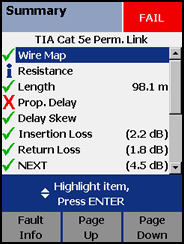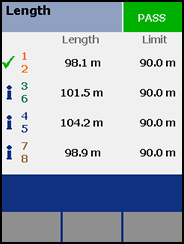Case Study 8 - Prop. Delay fails on DTX CableAnalyzer due to cable length
After the AUTOTEST, the installer was presented with the following DTX CableAnalyzer test result.

Propagation Delay increases with length. The longer the link, the more Propagation Delay you will see. When Prop. Delay fails, it is nearly always due to the link being too long. But in this case, Length did not fail. Mas espere! The maximum distance permitted for a Permanent Link is 90 m (295 ft). The result above exceeds that with a length of 98,1 m. Why did the DTX CableAnalyzer not fail on Length?
The 10% rule for length
From the industry approved cabling standard, ANSI/TIA-1152:
11.2.4.3.1 Physical length vs. electrical length
The Pass or Fail criteria is based on the maximum length allowed for the channel or permanent link given in figures 11-1 and 11-2 plus the NVP uncertainty of 10%.
Let's drill into the Length result on the DTX CableAnalyzer. To do this, highlight Length and press the ENTER key:

The DTX CableAnalyzer reports the length for each of the four pairs. Because each pair has a different twist ratio, each pair has a different length. Which length do we use? The standards requires Fluke Networks to use the shortest of the fours pair to report the overall length.
From the industry approved cabling standard, ANSI/TIA-1152 we find:
4.2.3.1 Physical length vs. electrical length
When physical length is determined from electrical length, the physical length of the link calculated using the pair with the shortest electrical delay shall be reported and used for making the pass or fail decision. The pass or fail criteria is based on the maximum length allowed for the channel or permanent link as specified in ANSI/TIA-568-C.2 plus the nominal velocity of propagation (NVP) uncertainty of 10 %.
If the limit is 90 m (295 ft) and the standards permit a + 10%. The DTX CableAnalyzer will not fail the Length test until the shortest of the four pairs exceed 99 m (324,5 ft) . This is also true for Channel testing, where the limit is 100 m. Therefore, in the case of Channel test limits, the length will not fail until the shortest of the four pairs exceed 110 m (360,8 ft).
That is why only one pair has the green tick mark against it. The other three pairs are marked "i" as information only.
This means that although the limit is 90,0 m, the tester will not fail the length parameter until the shortest pair of the four pairs has exceeded 90 m + 10 % (99 m). In the example above, the shortest pair was 98,1 meters, less than the 90 m + 10 % permitted by this standard.
Many customers do not like/agree with this feature. However, your DTX CableAnalyzer is standards based. Whilst Fluke Networks may not necessarily agree with the 10 % rule, the industry agreed to this. We implement the standard as is.
The downside to this rule is that installers tend to believe they can install links up to 99 m (324,5 ft). The danger in going beyond 90 m (295 ft) is that Prop. Delay will fail, as in this case. Be aware that Insertion Loss will probably become an issue - especially with Category 6A.
The installer exceeded the 90 m (295 ft) link requirement. The only way to fix this link is to try and find some slack in the cable and shorten the link.




